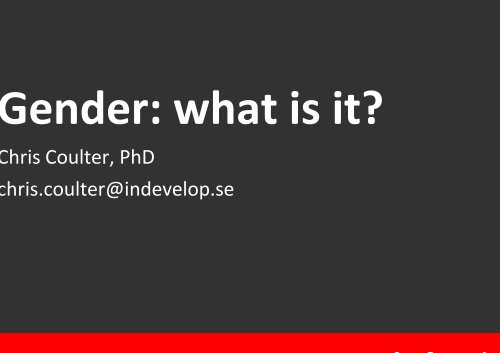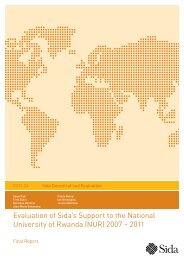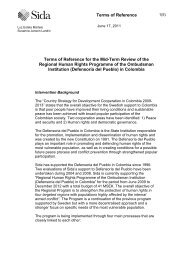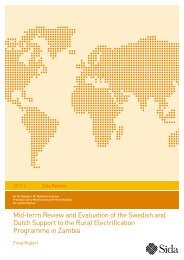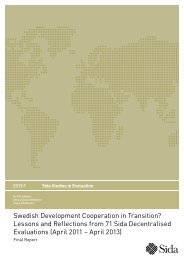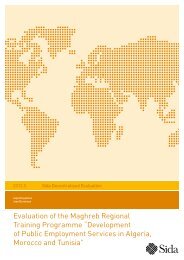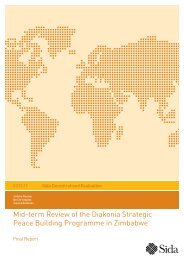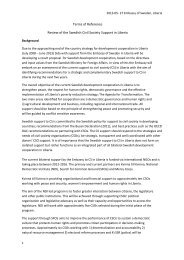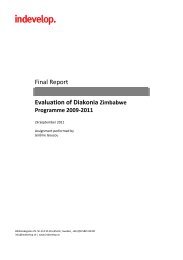Chris Coulter, PhD chris.coulter@indevelop.se
Chris Coulter, PhD chris.coulter@indevelop.se
Chris Coulter, PhD chris.coulter@indevelop.se
You also want an ePaper? Increase the reach of your titles
YUMPU automatically turns print PDFs into web optimized ePapers that Google loves.
ender: what is it?<br />
hris <strong>Coulter</strong>, <strong>PhD</strong><br />
hris.<strong>coulter@indevelop</strong>.<strong>se</strong>
So, what is gender?
SEX<br />
Biological differences<br />
between women and men
GENDER<br />
Cultural and social<br />
nterpretation of the biologica<br />
differences between women<br />
and men
Stereotypes
UESTION:<br />
To what extent does our community<br />
conform to traditional gender<br />
stereotypes?<br />
How do the<strong>se</strong> stereotypes affect<br />
children’s lives?<br />
Your life?
ender as process<br />
Something that can change<br />
Something that is done –<br />
as in ”doing gender”
ender<br />
Culture and context<br />
Socialisation<br />
Social and political relations between women and men<br />
Cultural variations<br />
Behaviour and opinions – individuals and organisations<br />
Can affect or strengthen other structural differences such a<br />
age, ethnicity, class, disability etc.
Gender = Women ?
Gender relations
Femininity<br />
&<br />
Masculinity
aspects of gender<br />
Assignment<br />
Role<br />
Identity<br />
Attribution
ssignment<br />
The gender we<br />
are given at<br />
birth, either male or female.<br />
In this aspect our genders are<br />
prescribed by the society in<br />
which we are born
ole<br />
This is the <strong>se</strong>t of behaviours,<br />
mannerisms, and other traits<br />
that society says we should<br />
express as part of our assigned<br />
gender = socialisation
entity<br />
This is what we think our gender<br />
should be at any given time.<br />
Many people do not question their<br />
gender and let their assigned<br />
gender function as their identity
ttribution<br />
This is the gender we assign<br />
people when we first meet<br />
them ans is ba<strong>se</strong>d on a <strong>se</strong>t of<br />
cues that differentiate from<br />
culture to culture
ender means …<br />
aspects of life that are organized by gender<br />
what it means to an individual to belong to a<br />
gender category<br />
other differences is associated to gender<br />
the different criteria u<strong>se</strong>d to differentiate the<br />
genders
ter<strong>se</strong>ctionality<br />
ivision of labor<br />
oles and responsibilities<br />
ontrol over resources<br />
thnicity<br />
ulture<br />
ge<br />
ocial class<br />
exual identity
ender Equity<br />
ender Equality
•Gender balance<br />
•Gender mainstreaming<br />
•Gender budgeting<br />
•Targeting
ender mainstreaming<br />
. Welfare<br />
. Access<br />
. Awareness-raising<br />
. Participation<br />
. Control
Gender analysis:<br />
•Quantitative data (statistics)<br />
−Sex disaggregated data<br />
•Qualitative data<br />
•Highlight specific vulnerabilities<br />
•Highlight potential for change<br />
•Always have an empowerment<br />
perspective
•International and national frameworks<br />
•Overall economic situation<br />
•Socio-economic situation<br />
•Socio-cultural cultural situation<br />
•Legal situation and human rights<br />
•Political situation<br />
•Media and IT
Measuring<br />
empowerment
dicators of empowerment<br />
Legal empowerment indicators<br />
Political empowerment indicators<br />
Economic empowerment indicators<br />
Social empowerment indicators
gal empowerment indicators include:<br />
the enforcement of legislation related<br />
to the protection of human rights;<br />
number of ca<strong>se</strong>s related to women’s rights heard in local courts, and their<br />
results;<br />
number of ca<strong>se</strong>s related to the legal rights of divorced and widowed<br />
women heard in local courts, and results;<br />
the effect of the enforcement of legislation in terms of treatment of<br />
offenders;<br />
increa<strong>se</strong>/decrea<strong>se</strong> in violence against women;<br />
rate at which the number of local justices/ pro<strong>se</strong>cutors/ lawyers who are<br />
women/men is increasing/decreasing;<br />
rate at which the number of women/men in the local police force, by rank<br />
is increasing or decreasing.
olitical empowerment indicators<br />
clude:<br />
• percentage of <strong>se</strong>ats held by women in local councils/ decision-<br />
making bodies;<br />
• percentage of women in decision-making positions in local<br />
government;<br />
• percentage of women in the local civil <strong>se</strong>rvice;<br />
• percentage of women/men registered as voters/ percentage<br />
of eligible women/men who vote;<br />
• percentage of women in <strong>se</strong>nior/junior decision-making<br />
positions within unions;<br />
• percentage of union members who are women/men;<br />
• number of women who participate in public progress and<br />
political campaigning as compared to the number of men.
ted over time:<br />
• changes in employment/unemployment rates of women and men;<br />
• changes in time u<strong>se</strong> in <strong>se</strong>lected activities, particularly greater<br />
sharing by hou<strong>se</strong>hold members of unpaid hou<strong>se</strong>work and child-<br />
care;<br />
• salary/wage differentials between women and men;<br />
• changes in percentage of property owned and controlled by<br />
women and men (land, hou<strong>se</strong>s, livestock), across socio-economic<br />
and ethnic groups;<br />
• average hou<strong>se</strong>hold expenditure of female/male hou<strong>se</strong>holds on<br />
education/ health;<br />
• ability to make small or large purcha<strong>se</strong>s independently;<br />
• percentage of available credit, financial and technical support<br />
<strong>se</strong>rvices going to women/men from government/ non-government<br />
sources.
cial empowerment, changes over time of:<br />
numbers of women in local institutions (e.g. women’s associations, incom<br />
generating groups etc.) to project are population, and numbers of women<br />
in positions of power in local institutions;<br />
extent of training or networking among local women, as compared to men<br />
control of women over fertility decisions (e.g. number of children, number<br />
of abortions);<br />
mobility of women within and outside their residential locality, as<br />
compared to men.
ualitative indicators<br />
To what degree are women aware of local politics, and their legal rights?<br />
Are women more or less aware than men? Does this differ by socio-economic<br />
grouping, age or ethnicity? Is this changing over time?<br />
Do women and men perceive that they are becoming more empowered? Why?<br />
Do women perceive that they now have greater economic autonomy? Why?<br />
Are changes taking place in the way in which decisions are made in the<br />
hou<strong>se</strong>hold, and what is the perceived impact of this?<br />
Do women make decisions independentlyently of men in their hou<strong>se</strong>hold? What sort<br />
of decisions are made independently?


